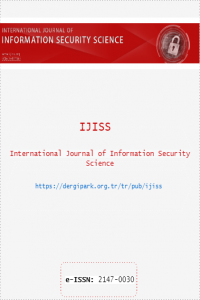Challenge of Malware Analysis: Malware obfuscation Techniques
Challenge of Malware Analysis: Malware obfuscation Techniques
It is a big concern to provide the security to computer system against malware. Every day millions of malware are being created and the worse thing is that new malware is highly sophisticated which are very difficult to detect. Because the malware developers use the various obfuscation techniques to hide the actual code or the behaviour of malware. Thereby, it becomes very hard to analyze the malware for getting the useful information in order to design the malware detection system because of anti-static and anti-dynamic analysis technique obfuscation techniques . In this paper, various obfuscation techniques are discussed in detail.
Keywords:
Dynamic Analysis, Malware Obfuscation Techniques, Static Analysis,
___
- Malware Statistics & Trends Report | AV-TEST. https://www.av-test.org/en/statistics/malware/ , 2017.
- V. Neumann, “Theory of self-reproducing automata”, Urbana, University of Illinois Press, 1966.
- J. Blackthorne, A. Bulazel, A. Fasano, P. Biernat, and B. Yener. “AVLeak: Fingerprinting Antivirus Emulators Through Black-Box Testing”, In WOOT’16 USENIX Workshop on Offensive Technologies, USENIX, 2016.
- B. Beaucamps, and J.Y. Marion, “On behavioral detection”, European Institute for Computer Antivirus Research Annual Conference, EICAR’09, 2009.
- M. Christodorescu, S. Jha, J. Kinder, S. Katzenbeisser, H. Veith, “Software transformations to improve malware detection”, Journal Computer Virology, Vol:3(4), pp no:253-265, 2007.
- Xu Chen, J. Andersen, Z. M. Mao, M. Bailey, and J. Nazario, “Towards an Understanding of Anti- virtualization and Anti-debugging Behavior in Modern Malware”. Dependable Systems and Networks With FTCS and DCC (DSN), 2008. Conference on
- E. Gandotra, D. Bansal, S. Sofat “Malware Analysis and Classification: A Survey”. Journal of Information Security, vol:5(2), pp no: 56-64, 2014.
- I. You, K. Yim, “Malware Obfuscation Techniques: A Brief Survey”, International Conference on Broadband, Wireless Computing, Communication and Applications, pp no: 297-300, 2010.
- Y. Gao, Z. Lu, Y. Luo, “Survey on malware anti- analysis”, IEEE ,international conference on Intelligent Control and information processing, 2014.
- T. Vidas, N. Christin, “Evading Android Runtime Analysis via Sandbox Detection”, ACM Symposium on Information, Computer and Communications Security. ACM, 2014.
- C. Thompson, M. Huntley, C. Link. Virtualization Detection: New Strategies and Their Effectiveness. Technical Report. University of Minnesota, 2010.
- A. Karnik, S. Goswami, R. Guha, “Detecting obfuscated viruses using cosine similarity analysis”, International Conference on Modeling and Simulation, pp no:165-170, 2007.
- B. Zhang, J. Yin, J. Hao, D. Zhang, S. Wang, “Malicious codes detection based on ensemble learning”, Springer In Autonomic and Trusted Computing, vol:46(10), pp no: 468-477, 2007.
- M. Cova, C. Kruegel, and G. Vigna, “Detection and Analysisof Drive-by-Download Attacks and Malicious JavaScript Code”, ACM International Conference on World Wide Web, 2010.
- M. Sikorski, A. Honig, “Practical Malware Analysis: The Hands-On Guide to Dissecting Malicious Software” Press, San Francisco,CA, USA, 2012.
- K. A. Roundy, B. P. Miller, “Binary-code obfuscations in prevalent packer tools”, ACM Computing Survey, Vol:46(1) pp no:1-4, ClamAV, 2013. [17]. Clamav, Available at http://www.clamav.net/index.html, 2017.
- S. Alam, R. N. Horspool, I. Traore, I. Sogukpinar, “A framework for metamorphic malware analysis and real- time detection”, Computers & Security ,vol:48, pp no: 212-233, 2015.
- R. Hedayat, The devil’s right hand: An investigation on malware-oriented obfuscation technique. Report, pp no:-31-67, 2016.
- F. Zhang , M. Yang, M. Xu “A malware analysis platform based on taint analysis”, IEEE International Conference on Computer Sciences and Applications, 2013.
- M. Egele, T. Scholte, E., C. Kruegel, “A survey on automated dynamic malware analysis techniques abd Tools”, ACM computing Surveys, 2012.
- W. Aman, “A Framework For Analysis And Comparison Of Dynamic Malware Analysis Tools”, International Journal of Network Security & Its Applications (IJNSA), Vol.6(5), 2014.
- K. Coogan, G. Lu, S. Debray, “Deobfuscation of virtualization-obfuscated software” Conference on Computer and Communications Security - CCS ’11, 2011.
- P. Burnap, R. French, F. Turner, K. Jones, “Malware classification using self organising feature maps and machine activity data”. Computers & Security, vol:73, pp no:399-410, 2017.
- T. Garfinkel, K. Adams, A. Warfield, J. Franklin, “Compatibility is Not Transparency: VMM Detection Myths and Realities”, USENIX Workshop on Hot Topics in Operating Systems, 2007.
- A. Dinaburg, P. Royal, M. Sharif, W. Lee, “Ether: Malware Extensions”, ACM Conference on Computer and Communications Security, 2008. Virtualization
- J. Boomgaarden, J. Corney, H. Whittaker, G. Dinolt, J. McEachen, “Challenges in Emulating Sensor and resource-Based State Changes for Android Malware Detection”, IEEE International Conference on Signal Processing and Communication Systems (ICSPCS), 2015.
- G. Pek, B. Bencsath, L. Buttyan. “Ether: In-guest Detection of Out-of-the-guest Malware Analyzers”, Fourth European Workshop on System Security, 2011.
- N. Miramirkhani, M.P. Appini, N. Nikiforakis, and M. Polychronakis, “Spotless Sandboxes: Evading Malware Analysis Systems using Wear-and-Tear Artifacts”, IEEE Symposium on Security and Privacy, 2017.
- D. Maier, M. Protsenko, T. Muller “A Game of Droid and Mouse: The Threat of Split-Personality Malware on Android”, Computers ad Security, vol:54, 2015.
- D. Maier, T. Muller, M. Protsenko, “Divide-and- Conquer: Why Android Malware Cannot Be Stopped”, IEEE Ninth International Conference on Availability, Reliability and Security (ARES’14), 2014.
- B. D. Gavitt, Y. Nadji, “See No Evil: Evasions in Honeymonkey Systems”, Technical Report 2010.
- M. A. Rajab, L. Ballard, N. Jagpal, P. Mavrommatis, D. Nojiri, N. Provos, and L. Schmidt. Trends in Circumventing Web-Malware Detection. Technical Report. Google, 2016.
- A. Kapravelos, M. Cova, C. Kruegel, and G. Vigna, “Escape from Monkey Island: Evading High-Interaction Honeyclients”, Springer International Conference on Detection of Intrusions and Malware,and Vulnerability Assessment (DIMVA), 2014.
- Yayın Aralığı: Yılda 4 Sayı
- Başlangıç: 2012
- Yayıncı: Şeref SAĞIROĞLU
Sayıdaki Diğer Makaleler
Challenge of Malware Analysis: Malware obfuscation Techniques
Jonathan KISSI, Baozhen DAİ, Benedicta A. CLEMENCY, Grace AMOAH-ANOMAH
